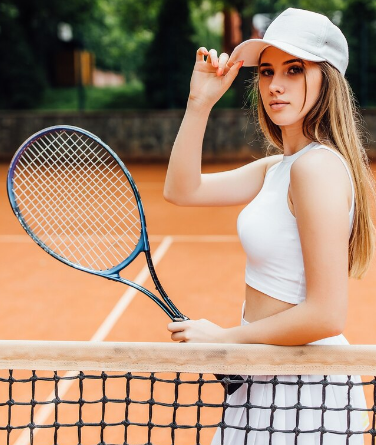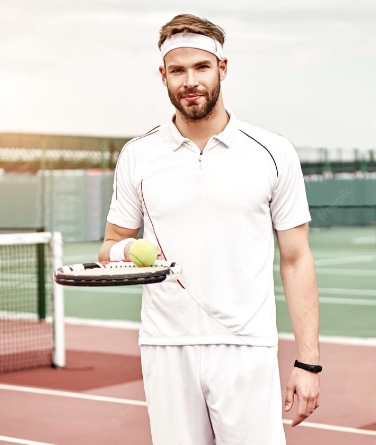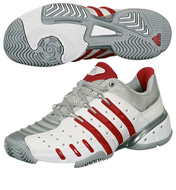Tennis clothes should incorporate socks and apparel composed of materials and fabrics that absorb perspiration; Allowing your skin to breathe is important so that heat and exhaustion don't become unbearable. Novel synthetic fabrics are engineered to wick or push the perspiration away from your body. Traditional cotton and acrylic are good for this anti-sweat purpose as well. Make sure the clothes are loose-fitting so that circulation is not impeded, accelerating exhaustion. Blisters, skin irritations, rashes can result from clothes that press down too tightly on any part of your body. You don't want clothes that pinch you because circulation shouldn't be inhibited in any way. Otherwise, you're more likely to get tired.
Wimbledon, an elite club in England, forces its members to wear pure, stark white when using its courts. Professional tennis competitors, with the exception of Wimbledon, are permitted to wear whatever they desire on the court. Humidity, heat, and even clay courts take away some of the newness and freshness of tennis clothes. Sliding out on a grass court can stain tennis clothes. Shorts are imperative because long pants and tennis are fundamentally at odds. It's not uncommon because soccer, basketball, and rugby use shorts too, presumably to catalyze air flow and cool the body during extending running and moving. Synthetic, wrinkle-free materials are advisable. Wearing bright, colorful patterns can distract your opponent and could give you an edge in the match.

Names like Lacoste and Ralph Lauren popularized the tennis shirt, and popular brands of tennis clothes today include Adidas, Diadora, Gamma, K-Swiss, Nike, and Wilson. Hats and visors, sweat bands for the forehead or wrist, socks, shorts, shirts, and sunglasses are all produced and heavily marketed. Any person that plays tennis regularly should purchase a tennis bag for the balls, racket, and sweaty clothes that accompany the game.

Most players on the professional tennis circuit are sponsored by different brands of tennis clothes. A nickname given by cynics is the walking billboard. Players sign contracts to wear certain clothes for certain matches or events. This is good advertising for the companies that support them. Players frequently change clothes during a match to feel fresher and lighter. Sometimes their clothes are drenched with sweat. There are nooks near center court, sometimes behind plants, where players can tuck in their shirts. However, players usually wait until a match is over to fully change clothes.
Retro tennis clothes are a cult phenomenon and point back to the nostalgia associated with Agassi's glory days. Many internet users roam the message boards and tennis forums looking for mail-order sources of these valuable vintage items. Some players prefer pure linen because of its high degree of suitability for summer days and inherent comfort and stylish look. Pleated tennis skirts are apparently out of style according to several retailers, and they are set to be positioned in the outmoded retro category. Personal interviews with store clerks all attest to this fact, however, the results could be local biases. All in all, it's best to scope out a tennis store to find the most fitting tennis clothes.

While the term "tennis shoes" is commonly used in reference to athletic shoes of any type, you should not wear running shoes, walking shoes, or cross-trainers when playing tennis. These types of shoes do not provide the correct support and can increase the risk of foot and ankle injuries. In addition, such shoes can also damage the tennis court surface.
There are several criteria tennis players should consider when selecting tennis shoes. First, the court surface you primarily play on will dictate the type of tennis shoe you need. Second, the characteristics of your feet and body will determine what type of tennis shoe is most comfortable and effective. Finally, as with any type of shoe, different people value certain shoe attributes and qualities more than others.
Tennis players that play on hard court surfaces should choose tennis shoes that are durable and resistant to wear. Repeated play on hard (i.e. concrete) courts will wear the tread off the soles of tennis shoes. Loss of tread leads to loss of traction and increased slipping. In addition, the part of the tennis shoe that covers the big toes should have extra protection on the outside. Tennis players often drag their toe while executing shots, especially the serve. It is crucial for right-handed players that the inside toe area of their right tennis shoe have extra protection to prevent premature wear. This area of the tennis shoe is particularly vulnerable because most right-handed players drag their right foot when serving, and often when executing forehand groundstrokes.
Tennis players that play primarily on soft court surfaces (i.e. clay) should select tennis shoes that are comfortable and provide good traction. Durability is less of a concern. It is also vital that the tennis shoe have a smooth, flat sole. The knobs and bumps found on the soles of running shoes and cross-trainers can damage clay court surfaces. In fact, most clay court facilities do not allow players to wear such shoes, instead requiring appropriate tennis shoes.
Feet and body characteristics are an important consideration when selecting tennis shoes. People who are prone to blisters must wear tennis shoes that fit properly and are well cushioned. Advances in tennis shoe technology have created cushioning systems that are lighter, more comfortable, and better at removing moisture. Body type is also an important consideration in tennis shoe selection. For example, larger and heavier players may prefer heavier shoes that provide extra support.
Finally, as with all types of shoes, personal preference and taste often determines what type of tennis shoe a person purchases. Many players desire a tennis shoe with a certain look or color scheme. On a more functional level, some players may select lightweight tennis shoes in an effort to enhance foot speed and agility.
After you determine the type of tennis shoe is right for you, it is important to select a shoe that fits properly. Because tennis involves a lot of sprinting, cutting, stopping, and starting, you should select a tennis shoe that fits snugly across the width of the foot. You should, however, make sure that your tennis shoes have at least a half-inch of space between the toes and the end of the tennis shoe.
Flexible Scheduling
